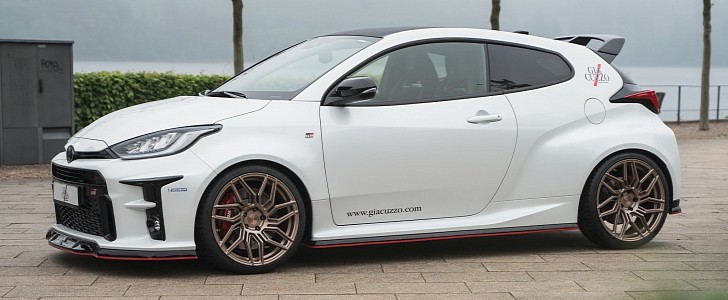It looks like a subcompact hot hatch on steroids, and due to its size, one might confuse it for a rival to the likes of the Volkswagen Polo GTI, Ford Fiesta ST, and Hyundai i20 N. However, the Toyota GR Yaris is actually a WRC homologation special and has few things in common with the normal hatchback.
The biggest difference between the two lies beneath the skin, as the GR Yaris is built around a combination of the GA-B (normal Yaris) and GA-C (Corolla) platforms. This has allowed the implementation of an all-wheel drive system, because, in case you forgot, it is an all-weather warrior.
Ever since it came out around two years ago (guess time really does fly), the GR Yaris has been subjected to all sorts of tests, and drag races. It won the hearts of those who have driven it, and some have even gone as far as calling it the closest thing to a road-legal rally car that money can buy.
Certain tuners have also had their way with the menacing model, including the one pictured in our image gallery, which came from Barracuda. Naturally, it rides on one of their wheel sets, dubbed the Dragoon, which measures 8.5x19 inches on both axles, has a high-gloss bronze finish and is hugged by the 235/35 tires.
Sitting closer to the ground due to the KW coilover suspension, the pictured GR Yaris sports a few other extras, such as the chin spoiler, side skirts, rear diffuser, and roof-mounted spoiler, which will set you back €289 ($328), €469 ($532), €319 ($362), and €439 ($498) respectively, in Germany.
To round off the project, they have also installed a new flap exhaust system, signed by Giacuzzo, which has probably bumped the output and torque by a tiny fraction over the 257 hp and 266 lb-ft (360 Nm) produced by the 1.6-liter three-pot in the European specification.
Ever since it came out around two years ago (guess time really does fly), the GR Yaris has been subjected to all sorts of tests, and drag races. It won the hearts of those who have driven it, and some have even gone as far as calling it the closest thing to a road-legal rally car that money can buy.
Certain tuners have also had their way with the menacing model, including the one pictured in our image gallery, which came from Barracuda. Naturally, it rides on one of their wheel sets, dubbed the Dragoon, which measures 8.5x19 inches on both axles, has a high-gloss bronze finish and is hugged by the 235/35 tires.
Sitting closer to the ground due to the KW coilover suspension, the pictured GR Yaris sports a few other extras, such as the chin spoiler, side skirts, rear diffuser, and roof-mounted spoiler, which will set you back €289 ($328), €469 ($532), €319 ($362), and €439 ($498) respectively, in Germany.
To round off the project, they have also installed a new flap exhaust system, signed by Giacuzzo, which has probably bumped the output and torque by a tiny fraction over the 257 hp and 266 lb-ft (360 Nm) produced by the 1.6-liter three-pot in the European specification.





















